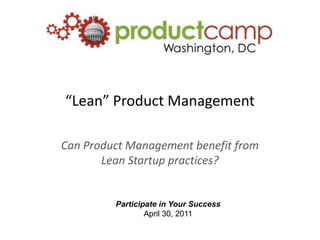
"Lean" Product Management
- 1. “Lean” Product Management Can Product Management benefit from Lean Startup practices?
- 2. 2 Thank You to Our Sponsors
- 3. About Me: Shardul Mehta Product management & marketing professional Early career: software developer Did my first start-up in 2000 Yes, I was a dot-commer! Small business, family business, enterprise, B2C, B2B, SaaS, web apps, healthcare, retail services, financial services MBA, Tepper Business School, Carnegie Mellon B.S., Computer & Information Sciences Twitter: @shardulmehta www.linkedin.com/in/shardulmehta http://streetsmartproductmanager.com
- 5. “Lean isn’t about being cheap [but is about] being less wasteful and still doing things that are big.” – Eric Ries http://theleanstartup.com 4
- 6. What is Lean Startup? + Eliminate Waste New Product or Service Low burn startup Speed of iterations is key to success Slideshare presentation “Building a Lean Startup” by Ash Maurya http://www.slideshare.net/ashmaurya/building-a-lean-startup
- 8. The fundamental activity of a startups is to turn ideas into products, measure how customers respond, and then learn whether to pivot or persevere. All successful startup processes should be geared to accelerate that feedback loop7 From http://lean.st/dharmesh
- 9. Capture business model hypothesis Systematically test our plan Formulate testable, falsifiable hypotheses Not measurable (“leap of faith”): Being known as an “expert” will drive early adopters Specific and testable: Blog post will drive 100 sign-ups Validate qualitatively, verify quantitatively Pick bold outcomes to generate strong negative/positive signals to stop, refine or seek permission to move forward Create accessible dashboards to measure progress Communicate learnings early and often Iterate our way to Product/Market fit Have we built something people want? “Steps” Expected outcome too vague Specific expected outcome based on repeatable action
- 11. Multiple canvases can be outlined in a single afternoon
- 12. Concise: distill your idea down to its essence
- 13. Portable: easier to carry, share, explain and updateFrom “Lean Startup is a Rigorous Process, Ash Maurya’s blog, http://www.ashmaurya.com/2010/09/lean-startup-is-a-rigorous-process/
- 15. Can it be solved? (Feasible)
- 17. Build MVP for early adopters
- 19. Prioritize and act on learnings
- 21. Are they telling others?Continuous validation via carefully scripted customer interviews
- 23. How do customers solve this problem today?Before we build the right solution, we have to understand the problem first Goal: Define a test possible solution (before implementing it) Customers are better at articulating problems than visualizing solutions Goal: Use feedback from the demo to distill the product down to its essence (MVP) to build and test qualitatively with customers A strong signal grants us permission to move forward, but does not guarantee scalability Goal: Verify qualitative signals with actionable macro metrics From Running Lean by Ash Maurya
- 24. Focus on the right stuff at the right time, and reduce waste Validate a problem is worth solving, before defining the solution Test our vision by measuring how customers behave Build a continuous feedback loop with customers throughout the product development cycle Find early (preferably paying) customers Decide what goes into Release 1.0 Identify ideal time to seek dollars and resources Test pricing Maximize for speed, learning and focus Iterate for Product/Market Fit in small increments Benefits of Lean Startup
- 25. 13 Thanks Again To Our Sponsors
